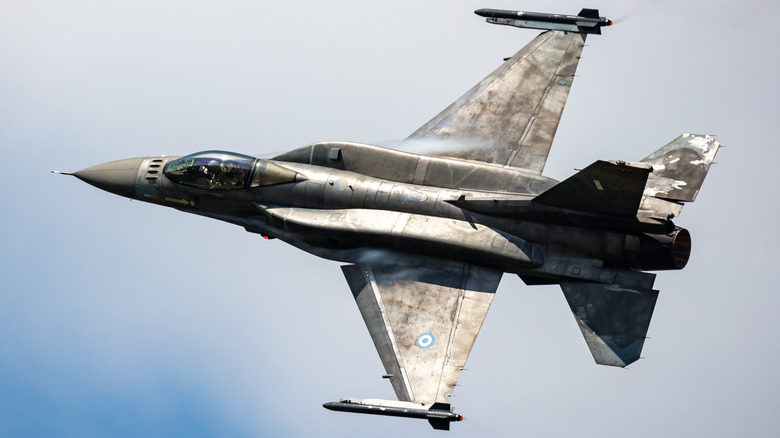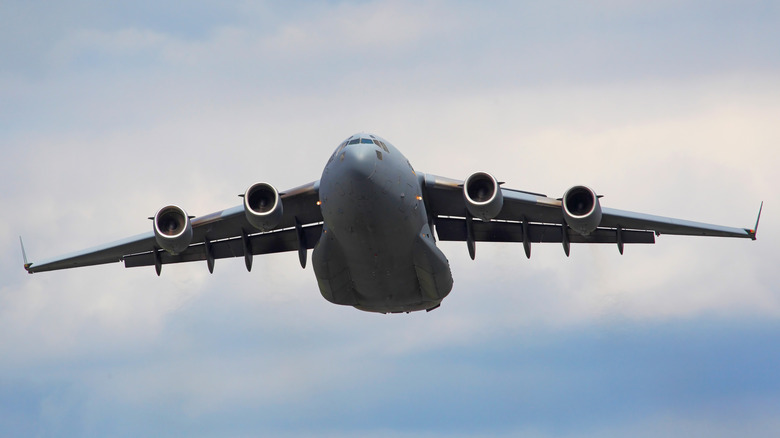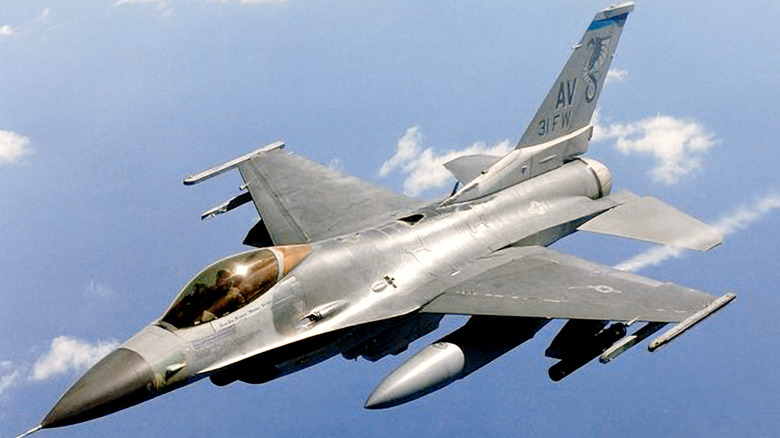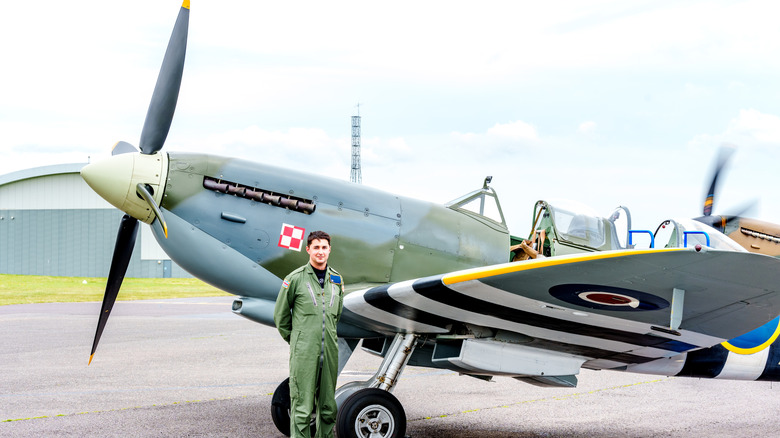Here's What The Letters Mean On Military Aircraft
We humans love to label everything we can, especially everything we make. You visit an art museum, and nearly every painting and sculpture bears its creator's signature. The same is true for military aircraft.
Most vehicles have some very weird names. Take one of the best commercial jets around, the Boeing 747-8, as an example. The first part of its name, Boeing, makes sense because Boeing Commercial Airplanes manufactured the vehicle, but what about the 747-8 part? Is it called the 747 because it's the successor to the Boeing 737? Surprisingly, no. What's with the 8 in its name? Since prior models were given labels such as the 747-100 and 747-400, why did Boeing go with 8? Why not 800?
Nobody except the designers can say for sure, especially because each commercial airline manufacturer tends to follow their own naming conventions. Military aircraft, however, obey far more rigid vehicle designation rules. At first glance, these labels might be a jumble of letters and numbers on par with a car license plate –- vanity plates notwithstanding. However, that alphanumeric chaos is only skin deep. Here we will take a look at the method behind the madness that is the U.S. military's aircraft designation system.
A primer on military aircraft designations
Before we start explaining how military aircraft designations work, we should probably ease you into the very concept of military aircraft designations.
The current military aircraft designation system — better known as the Tri-Service aircraft designation system – was initially introduced in 1962 and has undergone numerous revisions since then. The latest version was established in the November 3, 2020 rendition of the Air Force Instruction (AFI) 16-401 publication. Virtually every branch of the Department of Defense, including the U.S. Army, Navy, and Air Force, has to abide by the rules set forth in the AFI 16-401 document.
Despite the intentions of the original Tri-Service aircraft designation system, the new naming conventions were subject to some growing pains and more than a few headaches. For instance, every vehicle that was still in service and predated the original AFI 16-401 had to receive a new designation. Moreover, as technology improved and certain battlefield roles became obsolete, certain designations were either retired or reassigned — more on that later.
Perhaps most confusing of all, the definition of military aircraft is rather broad. The term applies to the usual suspects, such as fighter jets and cargo planes, but helicopters, VTOLs, and drones also qualify. Plus, even though they're more akin to weapon ammunition than anything most people would consider aircraft, missiles and rockets qualify as unmanned military aircraft and receive their own designation schemes. However, we won't be covering those vehicles and their symbols because the system is already confusing as it is.
How the symbols are arranged
When most people think about military aircraft, fighter jets such as the F-22 Raptor and the F/A-18 Super Hornet probably spring to mind. These names don't exactly roll off the tongue, but if you know anything about these planes, you're already well on your way to understanding military aircraft designations.
Every Department of Defense-related aircraft sports a label that looks like the following:
DCBA – XXX Z
Of all these symbols, only the B and XXX are essential, as they denote what an aircraft was built for and its design number, respectively. While the A is the first symbol next to the designation's hyphen, it is only used if the aircraft in question isn't a traditional airplane. If an aircraft was modified to serve a new purpose, the C is used to identify its new mission. Finally, the D denotes an aircraft's status, such as if it is experimental or a prototype, while the Z keeps track of whether a plane was upgraded from its base model and how many iterations came before it, if any.
You're probably wondering where Raptor and Super Hornet fall under military aircraft naming conventions. The answer is nowhere. These are just names that stick to the planes after an approval process that ensures they don't conflict with other names and aren't politically incorrect. These names are so unofficial that pilots generally ignore them.
First letter — Vehicle type symbols
The first letter to the left of the designation's dash is the most straightforward. If a vehicle is a normal airplane — e.g., it is powered, has fixed wings, is manned, and is not a VTOL capable vehicle — then it skips this symbol. If not, it uses one of these following symbols to indicate what kind of vehicle it is:
-
D = Unmanned Aerial Vehicle (UAV) Control Segment
Technically, aircraft that use this symbol are the integrated ground control equipment for UAVs, not actual aircraft. However, they are an integral part of UAV functionality, regardless. -
G = Glider
This symbol is used for fixed-wing aircraft that utilize air currents to perform unpowered flights. -
H = Helicopter
Aircraft that rely on rotary wings for lift and propulsion use this symbol. -
Q = Unmanned Aerial Vehicle
This symbol classification is broad and covers almost anything that doesn't carry a human pilot and can fly via remote control or programming. This category includes drones and balloons. -
S = Spaceplane
Aircraft designed to operate outside of the Earth's atmosphere then return safely back employ this symbol. -
V = VTOL & STOL
This symbol is reserved for VTOLs and STOLs, which are aircraft that can take off and land either vertically or with minimal runway distance, respectively. -
Z = Lighter-than-Air
Anything that uses hot or lighter-than-air gases for lift, such as blimps and balloons, has this symbol. This classification was allegedly included during the original 1962 designation revision for obsolete airships. When they were retired, this symbol was temporarily dropped from new designations.
Second letter — Basic mission and type symbols
Basic mission and type symbols indicate an aerial vehicle's original battlefield niche and is one of the only necessary letter symbols on a military aircraft designation. Any of the following symbols can be used for this purpose:
-
A = Attack
Aircraft designed to seek, attack, and destroy surface targets on land or sea, as well as provide close air support or "interdiction" (delaying or disrupting enemy forces or supplies) have this symbol. -
B = Bomber
Aircraft built to bomb enemy targets use this symbol. -
C = Cargo/Transport
Aerial vehicles designed to ferry personnel, cargo, or both utilize this symbol. -
E = Special Electronic Installation
This symbol is a catch-all classification for aircraft built for electronic warfare, airborne early warning radar detection, airborne command and control services (including communications relays), and tactical data communications links. -
F = Fighter
Aerial vehicles with this symbol are designed to engage and destroy enemy aircraft and missiles, and can provide interdiction ground support and close air support. -
L = Laser/Laser-Equipped
This symbol isn't a traditional mission classification but instead indicates that an aircraft carries a high-energy laser weapon. This designation was introduced to provide the YAL-1A Airborne Laser a special classification. -
T = Tanker
Aircraft that refuel other aircraft mid-flight receive this symbol. Sources such as the National Museum of the United States Air Force recognize this as a basic mission symbol, but the U.S. Naval Institute does not. -
O = Observation
Aircraft designed to observe enemy forces and supplies, either through visual or other means, and report this information back to headquarters use this symbol. -
P = Patrol
This symbol is for long-range, multi-engine, all-weather aircraft that operate out of land and water bases. These vehicles engage in antisubmarine warfare, maritime reconnaissance, and mining. -
R = Reconnaissance
Technically different from Observation aircraft, these vehicles carry out photographic and electronic reconnaissance. -
S = Antisubmarine
This symbol designates aircraft designed to identify, attack, and destroy enemy submarines. While identical to the symbol used for spaceplanes, this seeming oversight has yet to cause any confusion. -
T = Trainer
This symbol is used for aircraft designed for training purposes. -
U = Utility
This designation is given to aerial vehicles that can perform numerous missions, including battlefield support, localized transportation, and carrying small payloads. -
X = Research
This symbol is reserved for aircraft loaded with experimental equipment and configurations. Vehicles with this designation aren't considered tactically viable.
Third letter — Modified mission symbols
If engineers modify aircraft to fulfill new roles, the vehicle receives a new designation. If you see one of these letters to the left of a basic mission symbol, that means the aircraft was retrofitted to serve the following purposes:
-
A = Attack
This symbol indicates an aircraft was modified to seek, attack, and destroy enemy targets on land and sea, as well as provide interdiction and close air support. -
C = Cargo/Transport
This symbol is used for aircraft modified to carry personnel, cargo, or both. -
D = Director
This unique symbol indicates an aerial vehicle was granted the capacity to control drone aircraft and missiles. -
E = Special Electronic Installation
This symbol indicates a vehicle was modified to provide electronic warfare capabilities, airborne early warning radar detection, airborne command and control services, and tactical data communications links. -
F = Fighter
Aerial vehicles modified to intercept and destroy enemy aircraft and missiles use this symbol. -
H = Search and Rescue
Aircraft with this symbol have been modified to carry out search and rescue/MEDEVAC missions. -
K = Tanker
This symbol is reserved for aircraft that can refuel other aerial vehicles mid-flight. Once again, while the National Museum of the United States Air Force lists this letter as both a basic and modified mission symbol, the U.S. Naval Institute only recognizes it as a modified mission symbol. -
L = Cold Weather
While most mission symbols denote an aircraft's purpose, this symbol is reserved for aircraft modified with skis or special insulation to operate within the Arctic and Antarctic regions. -
M = Multi-Mission
This modified mission symbol has undergone several modifications of its own. It first stood for Missile Carrier when missiles were an uncommon armament, but after more planes started employing missiles, the symbol's meaning was changed to Mine Countermeasures and was given to planes with minesweeping equipment. Today, the symbol stands for Multi-Mission and is used for aircraft modified to carry out a multitude of jobs. -
O = Observation
Aircraft modified to observe enemy forces and supplies, then report this tactical information back to headquarters, use this symbol. -
P = Patrol
Aerial vehicles modified to serve as long-range, all-weather aircraft with multiple engines receive this symbol. These aircraft can launch from land or water bases and engage in antisubmarine warfare, maritime reconnaissance, and mining operations. -
Q = Drone
Aircraft modified to be controlled from far away and serve as UAVs receive this designation symbol. -
R = Reconnaissance
This designation is used for aerial vehicles modified with photographic and/or electronic reconnaissance equipment. -
S = Antisubmarine
This symbol indicates an aircraft was modified to find, identify, attack, and destroy enemy submarines. The same letter is also used to denote spaceplanes. -
T = Trainer
Aircraft that use this symbol were modified to fulfill training duties. -
U = Utility
This symbol indicates the aircraft was modified to perform various missions, including battlefield support and localized transport. -
V = Staff
Vehicles that use this symbol exclusively transport military and government personnel, including the President and Vice President of the United States. These aircraft are outfitted with chairs, tables, and a lounge. -
W = Weather
This modified mission symbol denotes aircraft upgraded to perform meteorological missions.
Design numbers
Immediately to the right of the designation's dash is a series of numbers. Unlike the letters, these don't have any hard and fast meanings — they're just numbers. However, they are still controlled by rules laid out by the AFI 16-401. At least, that's the idea.
As defined by the U.S. Naval Institute, each set of design numbers is meant to show that an aircraft is "a specific design of that particular type or basic mission." Plus, they are in sequential order to help readers know which designs were accepted before others. However, this rule is treated more like a guideline than an actual rule and not often enforced. For instance, no matter what a manufacturer's model number is, the aircraft's Tri-Service designation should follow prior aerial vehicle design number sequences.
However, Lockheed Martin's F-35 Lightning II violated this rule. Had it followed the sequence, it would have been named the F-24. Sometimes, however, there is a hint of logic behind this lack of adherence. For example, one plane was allegedly going to receive the designation C-34, but that model number was skipped to make it distinct from the Soviet-built T-34 tank. While that might sound ridiculous, imagine the confusion that could result from a low-clarity radio transmission where every C sounds like a T and vice versa.
Fourth letter — Series symbols
Directly to the right of the design numbers, you might find a letter such as A, B, or C. Unlike the mission symbols, these letters don't indicate an aircraft's purpose. Instead, they state if a vehicle has been modified or upgraded in a significant way. Not so much as it would be a different aircraft that can fill a new niche, but enough that the vehicle would require its own designation.
When an aerial vehicle is modified in such a way, the original model adopts the series symbol A, and the new iteration uses the symbol B. If the vehicle is significantly modified again, the newer version is given the letter C, and so on down the line. Sounds straightforward, but there are hiccups in the pattern. For instance, the letters I and O are not used since they can easily be confused with the numbers 1 and 0.
Some special aircraft break the rules due to certain design features. The F/A-18C/D is a good example because older versions are still manufactured and used alongside the newer ones. What's the difference? The C model has one seat, whereas the D version has two. That's it. These changes are so minor that unless you sat in a Super Hornet's cockpit, you probably could never tell the difference. People who compile manifests label the airplane with the somewhat generic F/A-18 C/D instead of listing them separately as F/A-18 C and F/A-18 D.
Final letter — Status prefix symbols
While most aerial vehicles employed by the Department of Defense are fully functional, not all are viable for use. No matter the reason, the AFI 16-401 catalogs them and provides an associated designation symbol. A label with the following letters to the left of a mission symbol indicates a vehicle's status:
-
e = Digitally Developed
This symbol is used for aircraft engineered in a purely virtual environment. Once the vehicle exits the initial phase of development, it loses this symbol. -
G = Permanently Grounded
When an aircraft is permanently retired from active duty but still in use, often for ground training, it is given this special symbol. -
J = Temporary Special Test
This symbol indicates that an aerial vehicle is being used as a testbed for equipment and configurations radically different from the standard build. Once the tests are complete, normal equipment will be reinstalled, and the vehicle will lose this designation. -
N = Permanent Special Test
Like the Temporary Special Test symbol, this letter indicates that an aircraft is being used as a testbed for a radically different configuration. However, this particular symbol indicates that reverting the aircraft to its original configuration is either impractical or not economically viable. -
X = Experimental
Not to be confused with the Special Test symbols, this letter denotes aircraft that are still being tested, so nobody knows what mission role they will fill. Aircraft with this symbol don't have standard mission symbols or design numbers. -
Y = Prototype
This symbol indicates an aircraft is still undergoing design and performance tests, and officials are evaluating its manufacturing costs and battlefield viability. These vehicles are produced in limited quantities. -
Z = Planning
This symbol is allegedly a holdover of prior design methods and indicates an aircraft is in the pre-development phase. This classification is rarely used.








